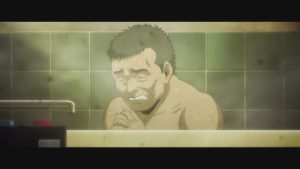 It’s been a big week for Gegege no Kitarou. It was officially confirmed that the series will air for at least a year, and a key visual was released for the upcoming “Seiyou Youkai-hen (Western Youkai)” Arc. This adaptations remains a singular event in anime, a family series with an enormous budget that’s succeeding massively in Japan (and totally tanking elsewhere). We still don’t know how many episodes worth of Sawashiro Miyuki Toei has in the can, and what the plan is for when they run out – and she’ll be very hard to replace. But that concern aside, this series is one of the best reasons to feel good about anime in a generally depressing creative climate.
It’s been a big week for Gegege no Kitarou. It was officially confirmed that the series will air for at least a year, and a key visual was released for the upcoming “Seiyou Youkai-hen (Western Youkai)” Arc. This adaptations remains a singular event in anime, a family series with an enormous budget that’s succeeding massively in Japan (and totally tanking elsewhere). We still don’t know how many episodes worth of Sawashiro Miyuki Toei has in the can, and what the plan is for when they run out – and she’ll be very hard to replace. But that concern aside, this series is one of the best reasons to feel good about anime in a generally depressing creative climate.
 It’s also a big week because Gegege no Kitarou released another landmark episode, probably about the sixth or seventh that’s stood out as truly exceptional (and most of the others have been excellent in their own right). One of the many miraculous things about this adaptation is how it manages to honor the history of the franchise and be totally in tune with it, while at the same time making no apologies for being a series of 2018. This time around it revisits one of the most beloved elements of the mythology, the youaki apaato (it’s been a good past year for those) in an especially ingenious way.
It’s also a big week because Gegege no Kitarou released another landmark episode, probably about the sixth or seventh that’s stood out as truly exceptional (and most of the others have been excellent in their own right). One of the many miraculous things about this adaptation is how it manages to honor the history of the franchise and be totally in tune with it, while at the same time making no apologies for being a series of 2018. This time around it revisits one of the most beloved elements of the mythology, the youaki apaato (it’s been a good past year for those) in an especially ingenious way.
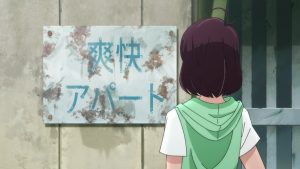 As always, the 2018 puts a spin on an old Mizuki tale while staying consistent with the core idea. The youkai apaato first popped up in the manga in 1971 (yes, I had to look up the date) but as far as I know, it’s never had an origin story quite this detailed. The episode starts out in 2018 with a young girl named Natsumi (Nakao Eri) excitedly chatting by cell with her boyfriend Hiro-kun (Kasai Yasunao) as she prepares to tear down a decrepit old apartment building. We see in flashbacks that it has a dark history – that it currently has no tenants seems the most logical thing in the world.
As always, the 2018 puts a spin on an old Mizuki tale while staying consistent with the core idea. The youkai apaato first popped up in the manga in 1971 (yes, I had to look up the date) but as far as I know, it’s never had an origin story quite this detailed. The episode starts out in 2018 with a young girl named Natsumi (Nakao Eri) excitedly chatting by cell with her boyfriend Hiro-kun (Kasai Yasunao) as she prepares to tear down a decrepit old apartment building. We see in flashbacks that it has a dark history – that it currently has no tenants seems the most logical thing in the world.
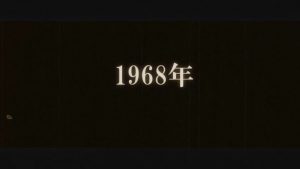 Things really get interesting when Kitarou-kun and Sunakake-babaa turns up at Natsumi’s door, asking to be heard out. That’s when the narrative flashes back to 1968, when Natsumi’s grandparents (Yamazaki Wakana – veteran of the 1996 and 2007 series – and Shimada Bin, 96/07/two movies, who should require no introduction) bought the building. Alas their first round of leasing is a disaster, as the “Soukai Apartments” have three standing youkai tenants – Rokuro-kubi (Hisakawa Aya, 96/07). Kasa-bake (Inada Tetsuo, 96/07) and Akaname (Kasuya Yuuta, 2007). They mischievously terrorize the new human tenants, and eventually Natsumi’s grandfather overhears some kids talking about the youkai mailbox and calls in Kitarou (and Sand Witch) for help.
Things really get interesting when Kitarou-kun and Sunakake-babaa turns up at Natsumi’s door, asking to be heard out. That’s when the narrative flashes back to 1968, when Natsumi’s grandparents (Yamazaki Wakana – veteran of the 1996 and 2007 series – and Shimada Bin, 96/07/two movies, who should require no introduction) bought the building. Alas their first round of leasing is a disaster, as the “Soukai Apartments” have three standing youkai tenants – Rokuro-kubi (Hisakawa Aya, 96/07). Kasa-bake (Inada Tetsuo, 96/07) and Akaname (Kasuya Yuuta, 2007). They mischievously terrorize the new human tenants, and eventually Natsumi’s grandfather overhears some kids talking about the youkai mailbox and calls in Kitarou (and Sand Witch) for help.
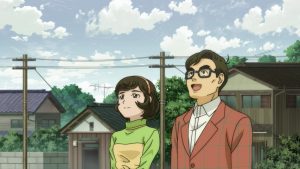 What a wonderful way to tie in the first GGGnK TV series this is, with the flashback sequences being especially effective at bridging many eras. These three youkai (all well-known in the Japanese lexicon of youkai) are basically small-timers, and Kitarou kicks their butts rather easily. But they love the dreary old building, and eventually Kitarou and Sunakake-babaa decide to let them stay on the grounds that they don’t let themselves be seen by the local humans. That doesn’t apply to the owners’ granddaughter (who they end up co-raising after the death of her mother – no mention of the dad), though – the trio end up being her playmates and best friends, to the point where Natsumi prefers their company to that of human children.
What a wonderful way to tie in the first GGGnK TV series this is, with the flashback sequences being especially effective at bridging many eras. These three youkai (all well-known in the Japanese lexicon of youkai) are basically small-timers, and Kitarou kicks their butts rather easily. But they love the dreary old building, and eventually Kitarou and Sunakake-babaa decide to let them stay on the grounds that they don’t let themselves be seen by the local humans. That doesn’t apply to the owners’ granddaughter (who they end up co-raising after the death of her mother – no mention of the dad), though – the trio end up being her playmates and best friends, to the point where Natsumi prefers their company to that of human children.
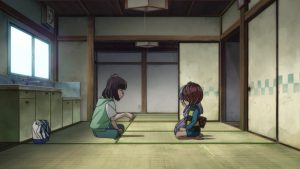 Like pretty much all great youkai series, the theme of the bittersweet nature of human-youkai relationships is at the very heart of Gegege no Kitarou. Kitarou himself sums this up with stunning elegance – “fear is the perfect distance”. Sand Witch convinces the three to disappear from Natsumi’s life for her own good, though it’s horribly painful for all involved (at least Natsumi will eventually forget – they won’t). In time she grows up and does forget, Grandma and then Grandpa pass away, and the Soukai Apaato is once again devoid of tenants, not because of youkai but simply because it’s grown increasingly derelict over the decades. Natsumi is eventually convinced by Hiro to tear it down – and he turns out to be the grandson (we know because Sunakaka-babaa recognizes his Versace jacket) of the yakuza boss who tried to bully her grandparents off the property in the 90’s before being smacked down by Team Kitarou.
Like pretty much all great youkai series, the theme of the bittersweet nature of human-youkai relationships is at the very heart of Gegege no Kitarou. Kitarou himself sums this up with stunning elegance – “fear is the perfect distance”. Sand Witch convinces the three to disappear from Natsumi’s life for her own good, though it’s horribly painful for all involved (at least Natsumi will eventually forget – they won’t). In time she grows up and does forget, Grandma and then Grandpa pass away, and the Soukai Apaato is once again devoid of tenants, not because of youkai but simply because it’s grown increasingly derelict over the decades. Natsumi is eventually convinced by Hiro to tear it down – and he turns out to be the grandson (we know because Sunakaka-babaa recognizes his Versace jacket) of the yakuza boss who tried to bully her grandparents off the property in the 90’s before being smacked down by Team Kitarou.
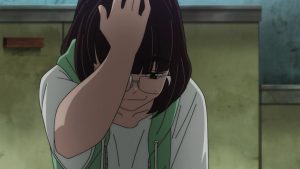 The moment when the youkai trio reveal themselves to Natsumi and she remembers is yet another gut-punch of an emotional payoff for this series. In the manga the building in question is indeed the “Youkai Apaato”, with youkai tenants, and now we know why – another square in the quilt of the mythology sewn into place by this stellar updating of the franchise. I only hope they pay rent like human tenants do, because warm feelings aren’t going to put food on Natsumi’s table…
The moment when the youkai trio reveal themselves to Natsumi and she remembers is yet another gut-punch of an emotional payoff for this series. In the manga the building in question is indeed the “Youkai Apaato”, with youkai tenants, and now we know why – another square in the quilt of the mythology sewn into place by this stellar updating of the franchise. I only hope they pay rent like human tenants do, because warm feelings aren’t going to put food on Natsumi’s table…


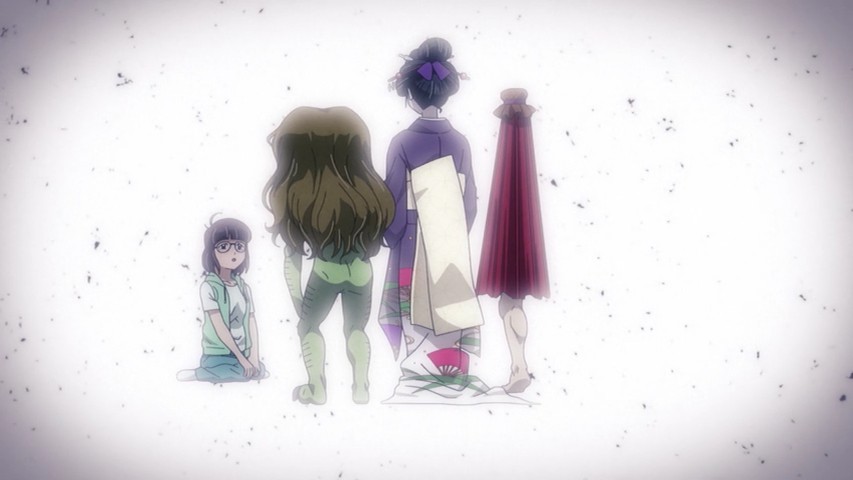
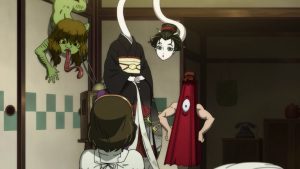
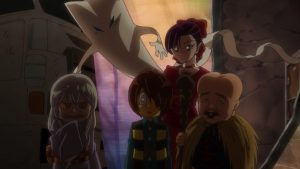
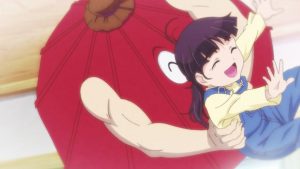
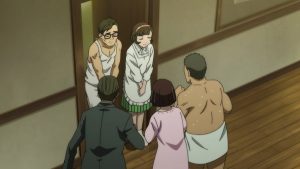

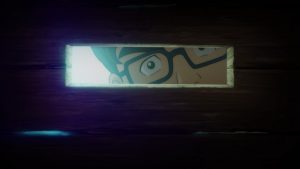
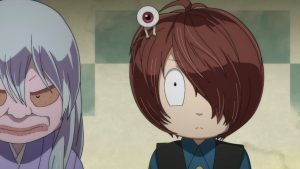

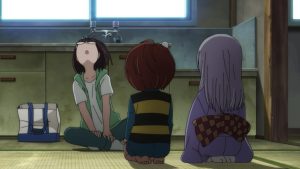


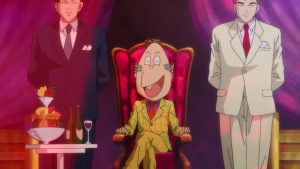
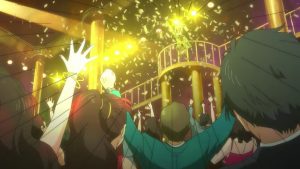
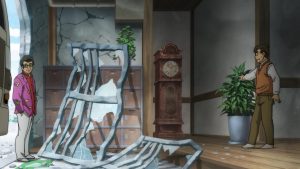
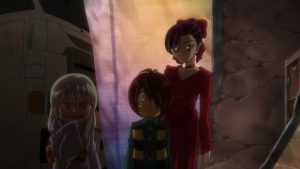

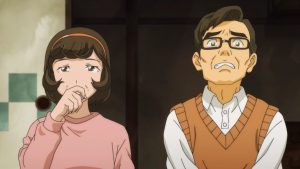
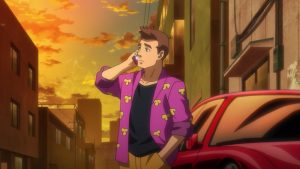
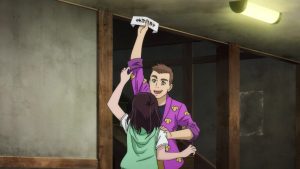

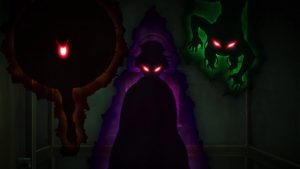


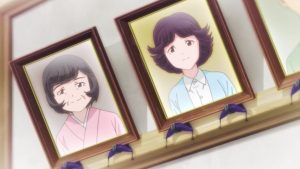
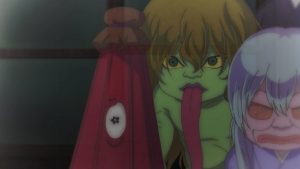
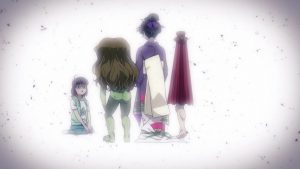

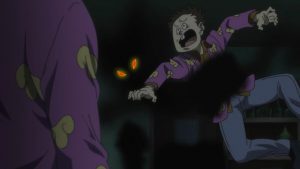
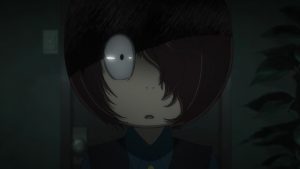






Dop
September 2, 2018 at 8:04 amDid anyone notice that the tune being hummed in the empty apartments at the beginning was the old song about grandfather’s clock? The one which “stopped short never to run again when the old man died”? Except here it did run again which was a nice touch.
Guardian Enzo
September 2, 2018 at 8:26 amJohnny Cash in Gegege no Kitarou, go figure.
Collectr
September 3, 2018 at 6:49 amThis episode was just right – tone, plot, continuity with the past. A full year of GeGeGe? I’m down with that.
I’m glad you identify the VA’s past connections with the franchise as part of your reviews. This highlights the current series’ commitment to honoring past as well as present.
Sawashiro Miyuki said she planned on a short maternity leave. Perhaps Toei won’t have to do too much bridging. Let’s hope, anyway.